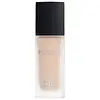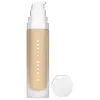Dior Forever Matte Foundation SPF 15 Versus Fenty Beauty Soft’Lit Naturally Luminous Longwear Foundation
What's inside
What's inside
 Key Ingredients
Key Ingredients

 Benefits
Benefits

 Concerns
Concerns

 Ingredients Side-by-side
Ingredients Side-by-side

Ethylhexyl Salicylate 3.5%
UV AbsorberTitanium Dioxide 0.94%
Cosmetic ColorantWater
Skin ConditioningMethyl Trimethicone
Skin ConditioningIsododecane
EmollientAlcohol
AntimicrobialSynthetic Fluorphlogopite
Butylene Glycol
HumectantPEG-9 Polydimethylsiloxyethyl Dimethicone
EmulsifyingAcrylates/Polytrimethylsiloxymethacrylate Copolymer
Skin ConditioningSilica
AbrasiveDimethicone
EmollientAcrylates/Dimethicone Copolymer
Skin ConditioningDisteardimonium Hectorite
StabilisingCetyl Dimethicone
EmollientPolyglyceryl-10 Decaisostearate
EmollientSodium Myristoyl Glutamate
CleansingParfum
MaskingPropylene Carbonate
SolventChlorphenesin
AntimicrobialAluminum Hydroxide
EmollientTromethamine
BufferingHydrolyzed Viola Tricolor Extract
Skin ProtectingTocopherol
AntioxidantAlumina
AbrasiveStearic Acid
CleansingTropaeolum Majus Flower/Leaf/Stem Extract
Skin ConditioningRosa Multiflora Fruit Extract
Masking1,2-Hexanediol
Skin ConditioningCaprylyl Glycol
EmollientIris Florentina Root Extract
MaskingSodium Benzoate
MaskingPotassium Sorbate
PreservativeCI 77491
Cosmetic ColorantCI 77492
Cosmetic ColorantCI 77499
Cosmetic ColorantCI 77891
Cosmetic ColorantEthylhexyl Salicylate 3.5%, Titanium Dioxide 0.94%, Water, Methyl Trimethicone, Isododecane, Alcohol, Synthetic Fluorphlogopite, Butylene Glycol, PEG-9 Polydimethylsiloxyethyl Dimethicone, Acrylates/Polytrimethylsiloxymethacrylate Copolymer, Silica, Dimethicone, Acrylates/Dimethicone Copolymer, Disteardimonium Hectorite, Cetyl Dimethicone, Polyglyceryl-10 Decaisostearate, Sodium Myristoyl Glutamate, Parfum, Propylene Carbonate, Chlorphenesin, Aluminum Hydroxide, Tromethamine, Hydrolyzed Viola Tricolor Extract, Tocopherol, Alumina, Stearic Acid, Tropaeolum Majus Flower/Leaf/Stem Extract, Rosa Multiflora Fruit Extract, 1,2-Hexanediol, Caprylyl Glycol, Iris Florentina Root Extract, Sodium Benzoate, Potassium Sorbate, CI 77491, CI 77492, CI 77499, CI 77891
Water
Skin ConditioningDimethicone
EmollientButylene Glycol Dicaprylate/Dicaprate
EmollientDiphenylsiloxy Phenyl Trimethicone
Skin ConditioningGlycerin
HumectantSynthetic Fluorphlogopite
Cetyl PEG/PPG-10/1 Dimethicone
EmulsifyingTrisiloxane
Skin ConditioningButylene Glycol
Humectant1,2-Hexanediol
Skin ConditioningTrimethylsiloxysilicate
EmollientDisteardimonium Hectorite
StabilisingPEG-10 Dimethicone
Skin ConditioningPolyphenylsilsesquioxane
Magnesium Sulfate
Dimethicone Crosspolymer
Emulsion StabilisingLauroyl Lysine
Skin ConditioningTriethoxycaprylylsilane
Aluminum Hydroxide
EmollientPolyhydroxystearic Acid
EmulsifyingEthylhexyl Palmitate
EmollientIsopropyl Myristate
EmollientIsostearic Acid
CleansingLecithin
EmollientTerminalia Ferdinandiana Fruit Extract
AntioxidantTrisodium Ethylenediamine Disuccinate
Polyglyceryl-3 Polyricinoleate
EmulsifyingCyperus Rotundus Root Extract
Skin ConditioningCI 77891
Cosmetic ColorantIron Oxides
Water, Dimethicone, Butylene Glycol Dicaprylate/Dicaprate, Diphenylsiloxy Phenyl Trimethicone, Glycerin, Synthetic Fluorphlogopite, Cetyl PEG/PPG-10/1 Dimethicone, Trisiloxane, Butylene Glycol, 1,2-Hexanediol, Trimethylsiloxysilicate, Disteardimonium Hectorite, PEG-10 Dimethicone, Polyphenylsilsesquioxane, Magnesium Sulfate, Dimethicone Crosspolymer, Lauroyl Lysine, Triethoxycaprylylsilane, Aluminum Hydroxide, Polyhydroxystearic Acid, Ethylhexyl Palmitate, Isopropyl Myristate, Isostearic Acid, Lecithin, Terminalia Ferdinandiana Fruit Extract, Trisodium Ethylenediamine Disuccinate, Polyglyceryl-3 Polyricinoleate, Cyperus Rotundus Root Extract, CI 77891, Iron Oxides
 Reviews
Reviews

Ingredients Explained
These ingredients are found in both products.
Ingredients higher up in an ingredient list are typically present in a larger amount.
1,2-Hexanediol is a synthetic liquid and another multi-functional powerhouse.
It is a:
- Humectant, drawing moisture into the skin
- Emollient, helping to soften skin
- Solvent, dispersing and stabilizing formulas
- Preservative booster, enhancing the antimicrobial activity of other preservatives
Aluminum Hydroxide is a form of aluminum. It can be naturally found in nature as the mineral gibbsite. In cosmetics, Aluminum Hydroxide is used as a colorant, pH adjuster, and absorbent.
As a colorant, Aluminum Hydroxide may add opacity, or reduce the transparency. Aluminum hydroxide is contains both basic and acidic properties.
According to manufacturers, this ingredient is an emollient and humectant. This means it helps hydrate the skin.
In medicine, this ingredient is used to help relieve heartburn and help heal ulcers.
There is currently no credible scientific evidence linking aluminum hydroxide in cosmetics to increased cancer risk.
Major health organizations allow the use of aluminum hydroxide in personal care products and have not flagged it as a carcinogenic risk at typical usage levels.
Learn more about Aluminum HydroxideButylene Glycol (or BG) is used within cosmetic products for a few different reasons:
Overall, Butylene Glycol is a safe and well-rounded ingredient that works well with other ingredients.
Though this ingredient works well with most skin types, some people with sensitive skin may experience a reaction such as allergic rashes, closed comedones, or itchiness.
Learn more about Butylene GlycolCi 77891 is a white pigment from Titanium dioxide. It is naturally found in minerals such as rutile and ilmenite.
It's main function is to add a white color to cosmetics. It can also be mixed with other colors to create different shades.
Ci 77891 is commonly found in sunscreens due to its ability to block UV rays.
Learn more about CI 77891Dimethicone is a type of synthetic silicone created from natural materials such as quartz.
What it does:
Dimethicone comes in different viscosities:
Depending on the viscosity, dimethicone has different properties.
Ingredients lists don't always show which type is used, so we recommend reaching out to the brand if you have questions about the viscosity.
This ingredient is unlikely to cause irritation because it does not get absorbed into skin. However, people with silicone allergies should be careful about using this ingredient.
Note: Dimethicone may contribute to pilling. This is because it is not oil or water soluble, so pilling may occur when layered with products. When mixed with heavy oils in a formula, the outcome is also quite greasy.
Learn more about DimethiconeDisteardimonium Hectorite comes from the clay mineral named hectorite. It is used to add thickness to a product.
It can also help stabilize a product by helping to disperse other ingredients.
Hectorite is a rare, white clay mineral.
Learn more about Disteardimonium HectoriteSynthetic Fluorphlogopite is the synthethic version of mica. It consists of fluorine, aluminum and silicate.
Synthetic Fluorphlogopite is used to add volume to products.
It is considered non-irritating on the skin.
Learn more about Synthetic FluorphlogopiteWater. It's the most common cosmetic ingredient of all. You'll usually see it at the top of ingredient lists, meaning that it makes up the largest part of the product.
So why is it so popular? Water most often acts as a solvent - this means that it helps dissolve other ingredients into the formulation.
You'll also recognize water as that liquid we all need to stay alive. If you see this, drink a glass of water. Stay hydrated!
Learn more about Water